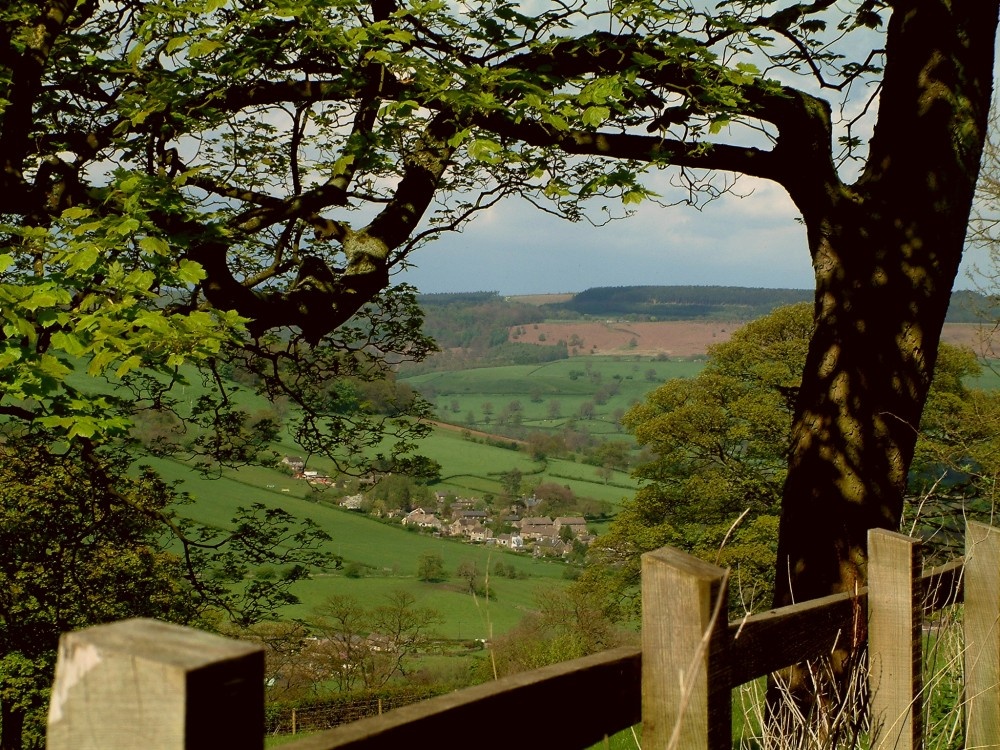
Rowsley village from Stanton in Peak, Derbyshire, The Peak District - Image by PicturesOfEngland.com member John Wright (view gallery)
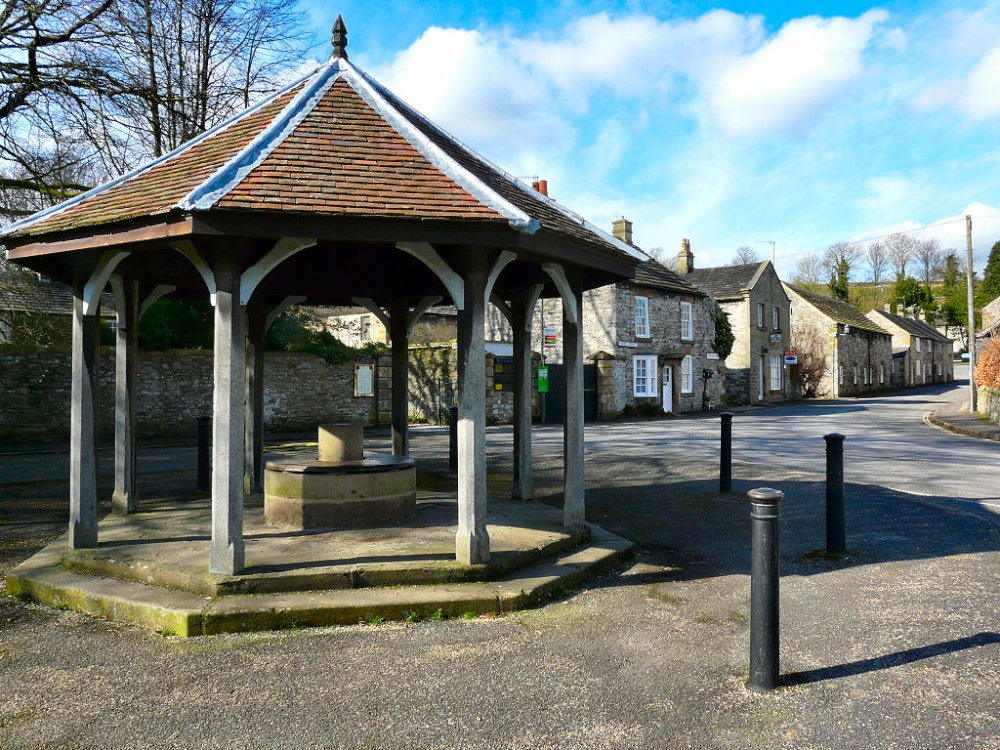
Ashford in the Water, Derbyshire - Image by PicturesOfEngland.com member Kevin Tebbutt (view gallery)
The dramatic limestone scenery of the Peak District can be seen following the course of the River Wye as it works its way from Buxton through a series of noted beauty spots until it reaches the picturesque village of Ashford in the Water which lies a short distance from Bakewell, home of the tasty Bakewell Tarts.
The beauty of the Wye is well documented but here it is made more vibrant with beautiful spring flowers growing at the waters edge beneath Sheep Dip Bridge, which is doubtless the main attraction of the village. Once a packhorse bridge, right up until recently sheep where brought here to be washed in the water prior to shearing. The concept was to pen the lambs on the one side of the river and throw the mothers in on the opposite side. The mothers would swim towards their young, ensuring a good soak resulting in a silky fleece.
Ashford is noted for its colourful well-dressing ceremony which is held here on the Saturday before Trinity Sunday when all six wells are dressed with a mass of beautiful flower petals and leaves. It is a lively event which attracts numerous visitors from out-lying areas who also enjoy the attractive village inns, lovely old stone houses and beautiful church. The church dates back to the 13th-century, it has a clock-faced tower crowned with graceful pinnacles. In the cool interior is a Jacobean pulpit and a chalice from the middle of the 17th-century. The church lies within a pretty tree-lines churchyard surrounded by graves covering past centuries.
The village was a centre for candle making, noted for lead mining and made famous by the discovery of Ashford marble which was first quarried by Henry Watson in 1748. The polished black marble was used for making clocks, vases and jewellery and made an exquisite background for colourful mosaic. The church has a handsome table top made in Henry Watson's factory which continued in production until around the 20th-century.
Ashford in the Water is a short distance from the steep slopes of wooded Taddington Dale above which rises Taddington, a spectacular limestone village and one of the highest in the country. The wooded slopes are preserved by the National Trust and face Monsal Dale in the east. Taddington Moor at 1,500 feet has the highest Megalithic tomb in England, it is an eyrie place wandered by sheep, where on a clear there are extensive views of exciting limestone formations and rolling countryside.
ID#418
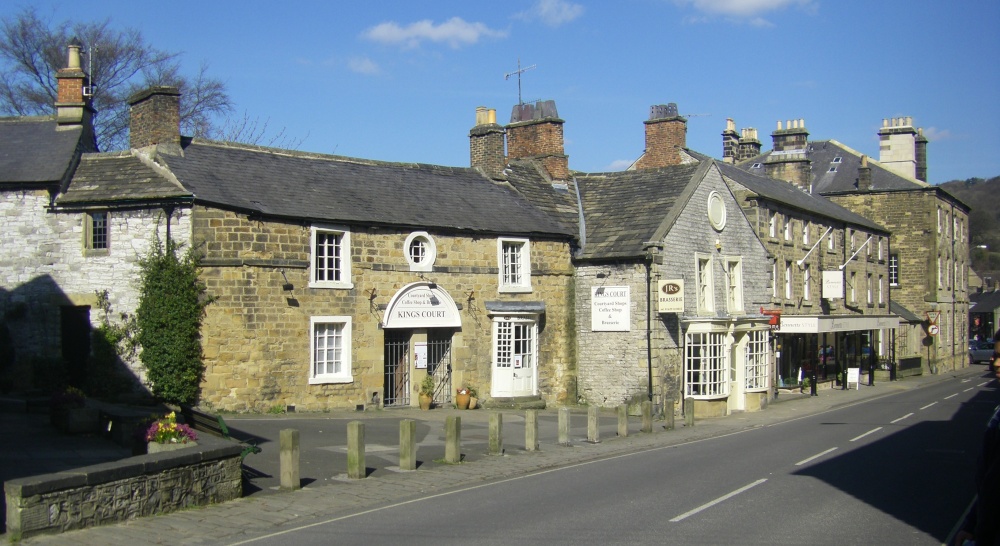
Character buildings - Image by PicturesOfEngland.com member Barbara Whiteman (view gallery)
Bakewell is the largest town in the Peak District National Park. It is an old town full of glowing stone houses and buildings that lend an air of ambience and overall warmth.
At the time of the Doomsday Book, the entry for Bakewell read "Badequella" meaning Bath-well, so we are assured the town has a long history, indeed some of the buildings here date from as far back as the 16th century.
Most people in the country have heard of Bakewell, quite possibly through the famous tasty Bakewell Tart. This is believed to have been first introduced by a cook at The Rutland Arms, a dignified building from 1804. The cook made a mistake with her ingredients, but this was discovered too late, the dish was served to the guests who happily confirmed it to be "delicious - keep on making it" thus the Bakewell Tart came into being, and has been made since this event took place in 1859!
Of the many interesting streets in the town is King Street, where you can find the former 18th century Town Hall. This lovely building has had a chequered history, it was used as a hospital for the poor, and a courthouse.
Mills form part of Bakewell's heritage, in 1777 Richard Arkwright opened a mill in the town, this brought more employement for the townsfolk and a much needed flurry of prosperity. The Victoria Corn Mill built late in the 18th century, belonged to the Duke of Rutland. This mill can be found just off the Bakewell Road, corn continued to be ground here until shortly after the 2nd World War.
Bakewell's beautiful parish church is a must for every visitor. All Saints was founded over a thousand years ago, and you can still see parts left from the original Norman building. It was altered during the 13th century, and later by the Victorians. It is a large church with a lot of spectacular church treasures including the table-tomb of Sir George Vernon who died in 1567. Sir George was often called "The King of the Peak" because of his lavish lifestyle and extravagant entertaining at his home, the near by Haddon Hall.
Another tomb in the church contains Sir George Manners, on this is a statue of his wife Lady Grace, who founded the original Lady Manners School in 1636. The slender spire topping the church is a noted landmark, and beneath in the surrounding churchyard visitors can see tombs and gravestones from several centuries.
The Old House, behind the church dates from 1534, this is a beautiful medieval building and it is now open as a museum of local history. Another interesting building is Bagshaw Hall, built by a wealthy lawyer in the 17th century and the Red Tudor House. The square named after mill giant Arkwright still contains some of the houses built for his mill workers.
Many visitors are drawn here by the wells, these have been an important feature of the town for centuries. Most of Bakewell's wells have been filled in but at the recreation ground you can see the Holywell, and Bath Well is in Bath Street.
Bakewell still clings to past traditions, the first market in the town was noted around 1300, and today Bakewell's market draws visitors from miles around. The annual well dressing ceremony is another well attended lively event, and a show is held every August. There is also an annual arts festival and for those wishing to learn at first hand some of the towns history there is an informative town trail.
One of the town's loveliest features is the graceful 5 arched bridge spanning the waters of the River Wye, this was originally built in the 13th century but widened in the 1800's. The banks of the Wye are a pleasant place to tarry for a while and enjoy a few moments of relaxation watching the colourful boats and rich river wildlife.
The town has a good range of accommodation, plenty of shops and several inns of note, these include the Queens Arms and the Peacock Inn both located close to the river, while in Bridge Street you will find the Castle Inn, the Wheatsheaf and Bridge House. In the town square is the Red Lion and the afore-mentioned Rutland Arms. Interestingly Jane Austen was a visitor to the Rutland Arms, she came here around 1811, later she used the inn as a setting for two of the love scenes in Pride and Prejudice, and called the town Lambton.
Bakewell is central for all the pleasures of the Peak District National Park and the great historic houses of Chatsworth and Haddon Hall, both lie within easy driving distance.
ID#332
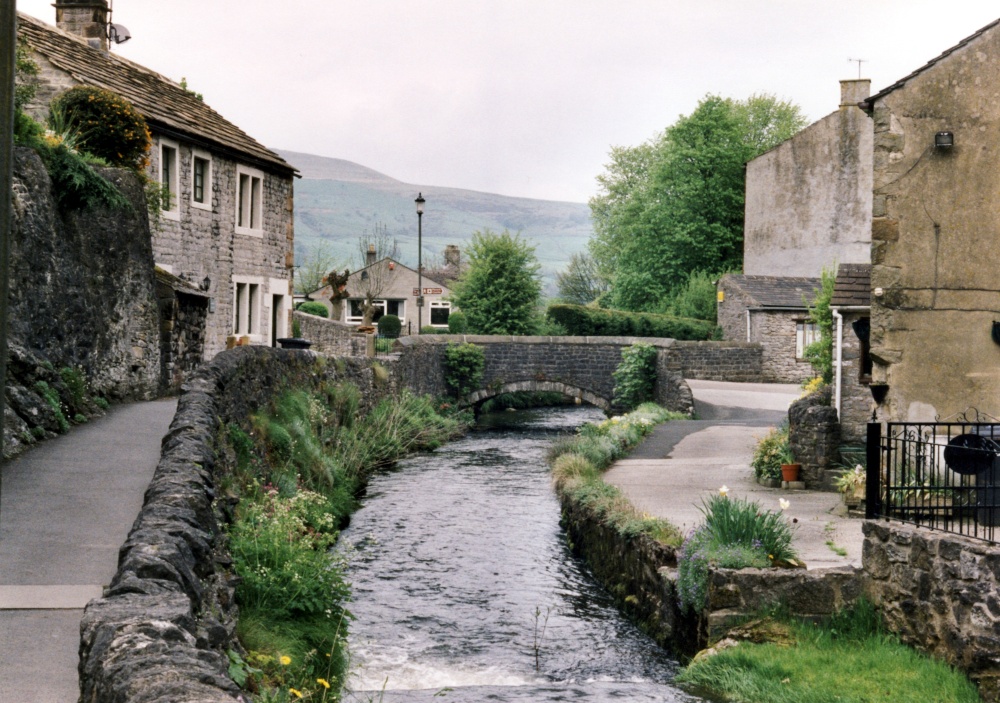
A picture of Peak Cavern - Image by PicturesOfEngland.com member David Walter (view gallery)
Castleton is one of the Jewels of the Peak District. It is a famous centre for caverns where you will find four of the countries most famous show caves. It is also the home of the ruined Peveril Castle, built in Norman times and immortalized forever in Sir Walter Scott's - Peveril of the Peak.
This is limestone country where the grandeur of the peaks is matched by the sheer brilliance to be discovered under-ground. Two caverns are both in Treak Cliff, these are beautiful places where floodlighting highlights the strange rock formations, the stalagmites, stalactites and the arch of Blue John stone. In the Blue John cavern there are spacious chambers and connecting passages running into the hills. Here you will find the famous stone in its natural setting, and gaze in wonder you might, for this glorious blue stone is found in no other place on earth. Fine pieces of Blue John have found their way to some historic places, it is believed to have been displayed in the Vatican Library in Rome, and good specimens can be seen in Chatsworth House and at Ashbourne parish church, both lie within the Peaks.
Peak Cavern, Devil's Cavern, and Speedwell Cavern are all equally impressive, with Speedwell lying beneath a spectacular ravine called the Winnats, found just to the west of the town.
Just as in the Spring Castleton celebrates Oak Apple Day, or Garland Day as it was once known, each Christmas the town hosts seasonal events in its famous caverns; Carols by Candlelight is held at Treak Cliff Cavern, and at Peak Cavern there is carol singing and a brass band.
The town's parish church is of Norman foundation and is dedicated to St.Edmund. The church we see today was largely rebuilt in 1837 with only the chancel arch remaining from the earlier church. The church tower has battlements and eight pinnacles, and inside you can see fine box pews, some inscribed with 17th-century dates.
The hope valley is highly picturesque with breath-taking scenery in every direction. Mam Tor, looms high over the village, this is thought to be where the Celts settled, there are the remains of a Celtic Hillfort at the summit in an enclosure of 16 acres. Here the altitude is around 1700ft.
For walkers this place is idyllic, a myriad of footpaths lead from Castleton taking you deep into the countryside, giving splendid views of lofty peaks and gentle river valley's. In Castleton itself there is a rich array of beautiful limestone buildings, including pubs. One of these, the Castleton Hotel dates 17th-century, as does the former Castleton Hall which is now a Youth Hostel.
Jubilant celebrations in Castleton commemorate the restoration of Charles II. On 29th May each year a group of Morris Dancers led by a King and Queen accompanied by a band parade through the streets of the town to the Market Place. The King is covered in flowers, and everyone dances as they celebrate the restoration of the Monarch, and the coming of Spring.
Castleton offers visitors a wealth of interest, it has well stocked local shops, gift and galleries, a splendid range of accommodation for those wishing to stay and explore, or it makes a lovely destination for a pleasant day out - but beware, stout walking shoes are essential!
ID#5539
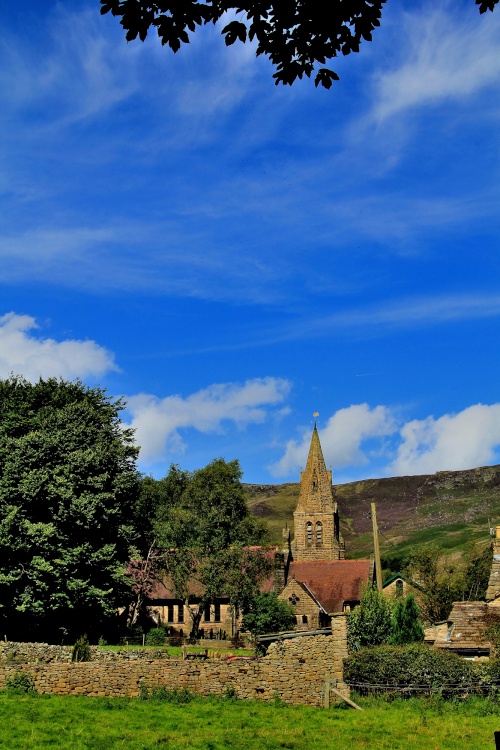
Edale Parish Church - Image by PicturesOfEngland.com member Tom Curtis (view gallery)
Gloriously situated in the lofty heights of the Peak District National Park, the lovely village of Edale is the start for the torcherous 250 mile trek along the Penine Way to Scotland. The village is in outstanding countryside wedged between the towering limestone peak of White Peak and the gritstone, Dark Peak, it is a landscape of unimaginable beauty and splendour. The village streets are lined with ancient cottages and houses of differing styles but built with the uniformity of stone as the main building material, as if in defiance of the icy winds that blast through these bleak upland regions. The old church is strongly built of stone, its steeple soars skywards as if to dominate and dwarf the rest of the village.
Edale was first recorded in the Domesday Book of 1086 and so it is an ancient place. In Elizabethan times much of village life centred around five cattle farms and it was not until the 18th-century that the vast lands were broken up into parcels of fields bounded by stone walls, and flooded with sheep. Sheep, graze these lands to this day. In sprintime, the vista is of frolicsome baby lambs amid rich green fields, while autumn brings a dramatic change the hills aglow in a mixture of glorious russet and rich purple. Winter brings its own delight with snow capped peaks and icy water tumbling down ragged ravines that can only be crossed by old rustic bridges. The long lazy days of summer are special, the land takes on a radiance, the views so clear, it6 is almost like the words to the song ' on a clear day you can see forever more'.
A stay in Edale can be as hectic or as peaceful as you wish. You can join organised walks or take a gentle stroll. There is a local Riding and Pony Trekking centre that offers varied activities, or you can simply relax and soak up the peace and quietness, hard to find in the world busy world beyond.
Attractions close to Edale include; Blue John Cavern, Treak Cliff Cavern, the village of Castleton, Speedwell Cavern and Peak Cavern.
ID#12878
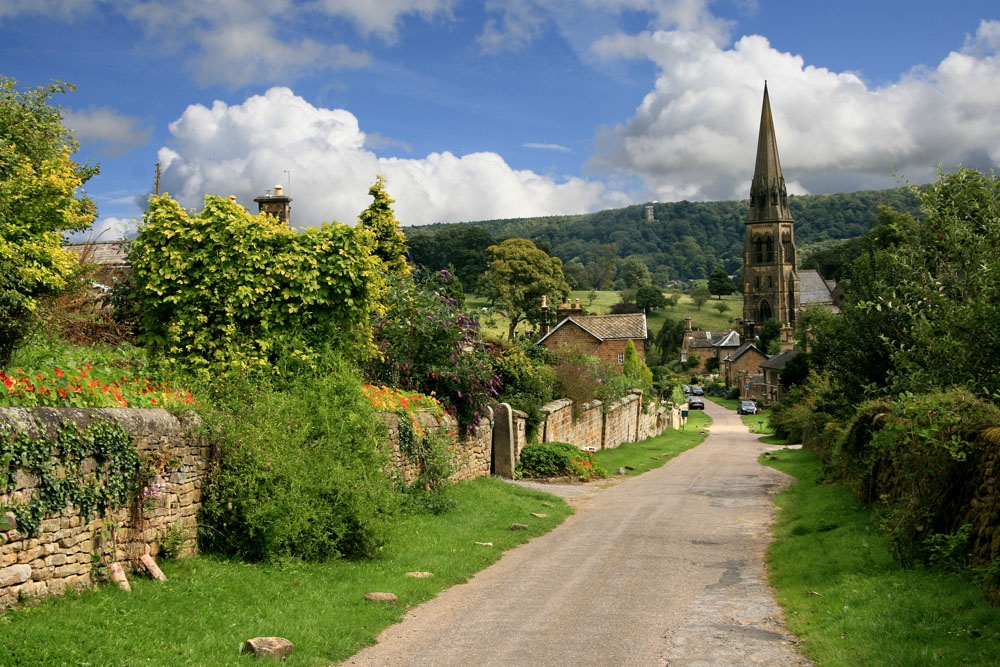
Edensor - Image by PicturesOfEngland.com member John Godley (view gallery)
It was the 6th Duke of Devonshire who looked out of his window one day from Chatsworth House, and realised that the magnificent view of the park in front of him was blocked by a village - so he had it moved, quite literally, over the hill and out of sight.
That village was Edensor (pronounced Enzer) and the move happened in 1839 when the Duke tasked his gardener Joseph Paxton with moving the entire village (apart from one cottage who's tenant didn't want to move) to a newly chosen site west of Chatsworth House, where it was rebuilt to the designs of John Robertson, with no two houses built alike, being placed well apart surrounding a broad green planted with Laburnum trees. A mix of architectural styles were given to the buildings, such as Swiss-chalet roofs, Jacobean gables, Italian-style windows, Tudor chimneys and Georgian doorways.
Most of the village buildings today are listed buildings, including the magnificent St Peter's Church, which is Grade I listed and was rebuilt and expanded between 1867 and 1870. It replaced an ancient church which dated back to the 12th century.
ID#13798
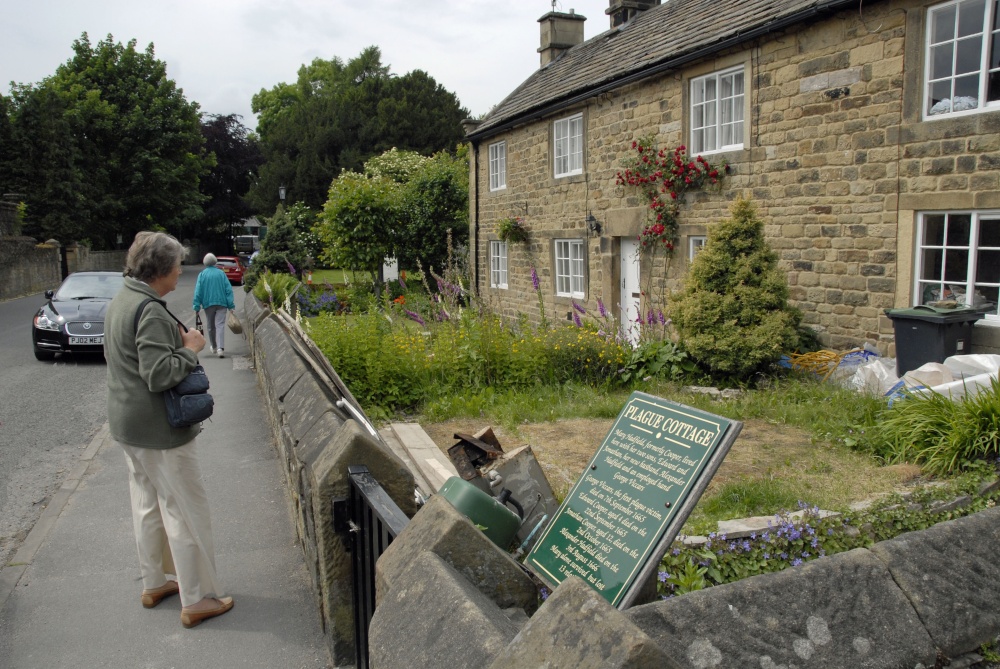
Eyam Village, known as the Plague Village - Image by PicturesOfEngland.com member Paul V. A. Johnson (view gallery)
The glorious Peak District has many handsome stone villages who have carved for themselves a place in history. Eyam, was naught but a tiny hamlet when in 1665 a clothes chest was delivered to a cottage. It came from London which at the time was riddled with the Plague. In no time at all, once the chest was open, plague germs spread and almost two thirds of the village population was wiped out! The fact that the remaining villagers were saved is due to the foresight of the local rector, William Mompesson and his predecessor, Thomas Stanley, who led the villagers into isolation and held church services on a nearby crag, in the open air until the village was free from decease. An annual commemorative service for those who died is still held in this spot. The cottage where the tainted clothes were delivered can still be seen.
Setting its chilling history to one side, this is a village with a lot to offer. It is hidden away in a matchless location above the limestone peaks of Middleton Dale. Its long village street is dotted with cottages from the 17th and 18th-century and its pub, the Miners Arms, dates from 1630. The name of the pub is indicative of the lead and mineral mining industries of the area, and interestingly the pub is supposed to be haunted.
Eyam Hall has dominated this little village for centuries. It was the home of the Wright family for over 300 years. It is now open to the public who can view a fascinating collection of family memorabilia including furniture, paintings, costume and other personal items. It is a comfortable house, evocative of times past, where you can almost feel the presence of the people who had loved and cared for their home for centuries.
In the churchyard of the village church you can see a Saxon Cross of the 7th-century. It is believed to be the best preserved of its kind in the Peak District. You can also see the graves of villagers who died from the plague. Inside the church there is a display of the story of the plague and its effect on Eyam. The church has medieval wall paintings, and fonts from the Norman and Saxon periods.
From the village there are sweeping views over the surrounding countryside, and at nearby Eyam Moor you can see stone circles and an ancient burial mound, it is an ideal vantage point with views extending across the Derwent Valley.
Nestling in its high upland position the village of Eyam throbs with life and in spite of its sad history, it is a lovely relaxing place to visit.
ID#13419
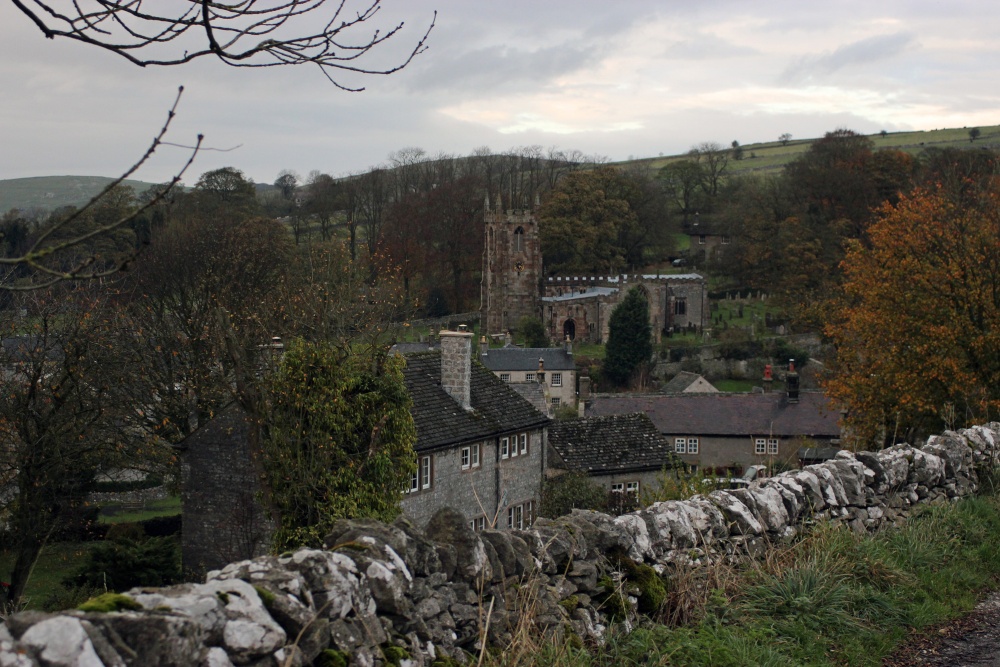
Hartington Church and Village, Derbyshire - Image by PicturesOfEngland.com member Karen Lee (view gallery)
Hartington is a small village centred around a medieval market place, with attractive 18th and 19th century buildings. Amongst these is the parish church of St.Giles which stands above the market square surrounded by ancient graves and tombstones.
The village has a pleasant atmosphere, in the summer months it is a "hot spot" for tourists and walkers as there is access from the village to many of the upper Dove's most beautiful regions, including the beautiful Beresford Dale. It has a few souvenir shops and friendly cafe's.
Hartington Hall is a lovely manor house of the Tudor era, it was built by Robert Bateman in 1611, and local legend tells that Bonnie Prince Charlie stayed at the manor in 1745. The house is beautifully gabled, with fine oak panelling to the interior, it is now an atmospheric youth hostel.
The village celebrates the life of Charles Cotton who was born at nearby Beresford Hall, the village pub is names after him. Charles Cotton, together with his friend Isaac Walton, wrote "The Complete Angler" it was Cotton who introduced Walton to the delights of the Peak District, particularly the beautiful River Dove.
In the village square is a shop selling Stilton cheese, this is made in a factory located at the edge of the village. Also, a little way out of the village visitors can find what remains of the old Hartington railway station. This is now a pleasant picnic area, with visitor facilities, and a small information centre in what was formerly the signal box. The rail track forms part of the Tissington Trail, used by both cyclists and walkers.
The village is a prosperous place, as evidenced by the many picturesque properties dotted around. The surrounding landscape is home to a few scattered farms, this is less open than in medieval times and is criss-crossed by stone walls affording protection to sheep and cattle from the perilous winds known to wreak havoc across the wild hills and valleys of the Peak countryside.
ID#14341
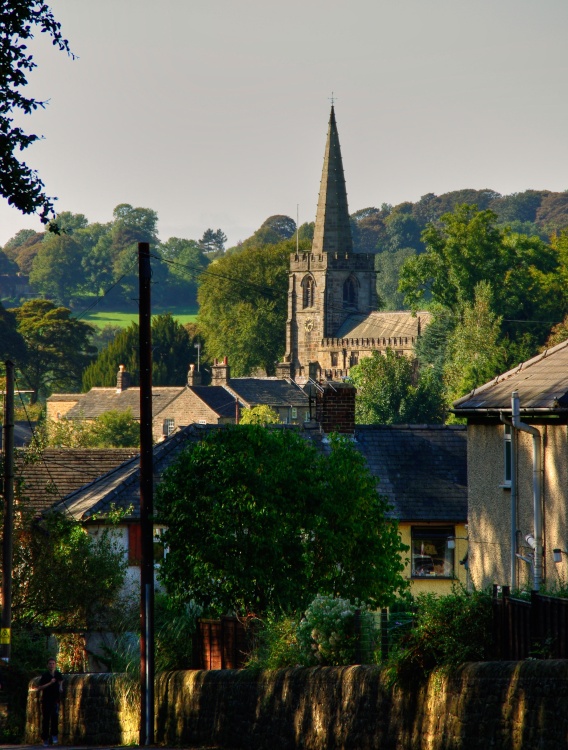
Hathersage Church - Image by PicturesOfEngland.com member Mick Carver (view gallery)
This small town set in the beautiful Hope Valley was a place often visited by the Bronte family. Charlotte Bronte stayed here with her friend Ellen Nussey in the vicarage and perhaps this is why she chose North Lees and Moorseats Hall, both of which are close-by, as settings for her novel Jane Eyre. Her desk is still kept at the vicarage, and the arms of the Eyre family are over the church porch. Inside the church there are brass portraits depicting generations of Eyres. Robin Hood's friend, Little John is said to be buried in the churchyard.
The terrain is little changed since these romantic times and Hathersage, once walked by the heroines of yester-year, is now a favoured centre for walkers. From the town you can take upland and lowland paths and enjoy numerous sporting activities, such as climbing, abseiling, caving, gliding and potholing.
It is a pleasant, atmospheric town which prior to the 18th-century was largely agricultural with a few people engaged in cottage industries making wire and brass buttons. In 1750, Henry Cocker opened his Atlas Works and began to mass produce wire causing the demise of the cottagers trade. His mill brought much prosperity to the town and by the start of the 19th-century several mills were in operation and the town had become famous for the manufacture of pins and needles. By the end of the 19th-century the industry had moved to Sheffield and the last mill in Hathersage closed in 1902. Interestingly, some of the old mills can still be seen in various parts of the town.
The town now takes advantage of its superb position, operating mostly as an attractive place for tourists. It offers a wide range of accommodation which includes friendly B&B cottages, to camping sites, youth hostels and old coaching inns. Wherever you stay and whatever you do, there will always be lots to interest and admire, not least the towering scenery of the spectacular Peak District National Park.
ID#13104
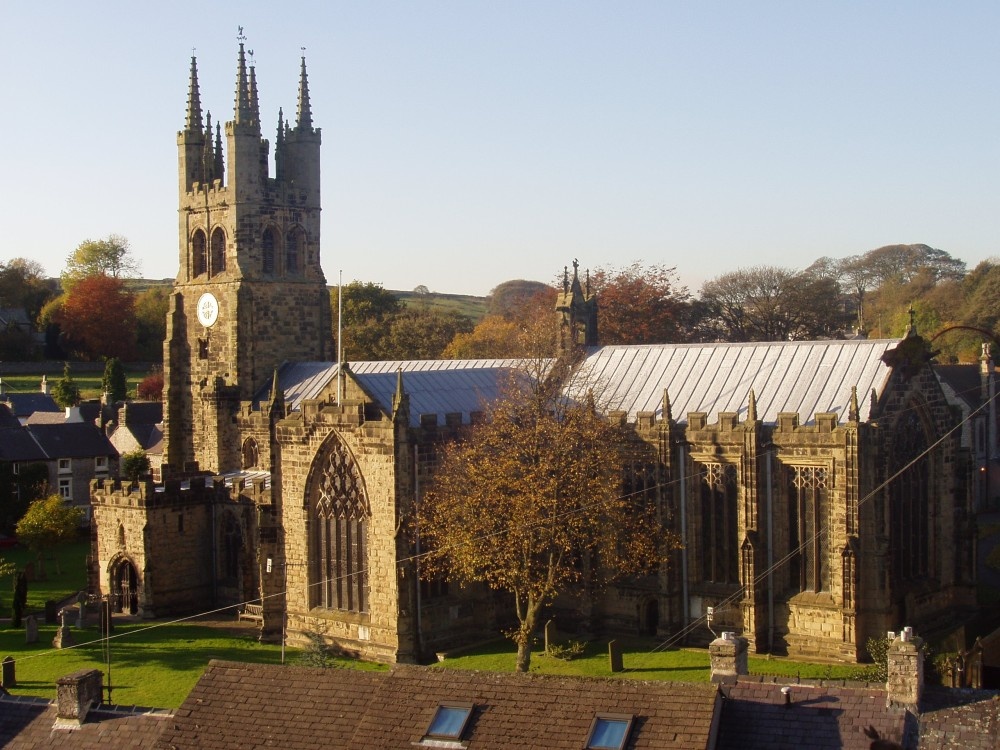
Tideswell Church, known as 'Cathedral of the Peak'. The centre piece of the village. - Image by PicturesOfEngland.com member Dave Bradwell (view gallery)
Tideswell is famous for its superb, large church, known as the "Cathedral of the Peak".
The village is a lovely, small place set amongst the limestone hills of the High Peak, and indeed its premier feature is the magnificent parish church dedicated to St.John the Baptist, which has a high, heavy, eight pinnacled Perpendicular tower, one of the earliest of its kind in England. The church was erected during the 14th century and houses a fine collection of pre-Reformation monuments, included in these is what is considered to be the finest single brass in Derbyshire, this dates from 1383 and commemorates John Foljambe. The church has fortunately remained largely unaltered, it is beautifully proportioned with many fine interior features including majestic traceried windows allowing rays of light to dapple the splendid wood, stone and marble. The church is the burial place of William Newton, well known as a poet and often referred to as "The Minstrel of The Peak".
The history of the village began in Roman times. When the Doomsday Book was first compiled it was part of the parish of Hope, but all this changed when it was granted to Thomas Armiger, and gained a market charter. Tideswell flourished during the heady days of the "lead" and "wool" trades, it became a noted centre for both commodities, causing an expansion in housing to accommodate the growth in population. By the 19th century it had become one of Derbyshire's foremost villages, noted for the production of textiles. It had small factories producing silk handkerchiefs and scarves, and close to Tideswell were the nearby mills of Cressbrook and Litton, both known for the production of fine cotton.
Today, Tideswell is an attractive inland resort with a wealth of interest for the visitor. It has lovely walks and Tideswell Dale leads towards Litton Mill is protected as a Derbyshire Wildlife Nature Reserve, with an abundance of beautiful rare flowers. The village is well known for its annual well-dressing ceremony, the start of week long festivities, with parades, carnival, music, Morris and folk dancing, it is all much fun for everyone, whatever age!
Apart from the church there are plenty of other impressive properties to be seen, included in these is the fine library building, some lovely old cottages and quaint shops, and not to be missed is the handsome, evocative War Memorial sited in Market Square.
Tideswell can be located just off the A623 between Baslow and Chapel-en-le-Frith, it is also close to the lovely old town of Buxton. The village makes an ideal centre for anyone wishing to explore the district of the High Peak, the glorious Howden Moors and reservoir, and Castleton, rich in historic caverns and caves where you can see wonderful semi-precious stones.
ID#13469
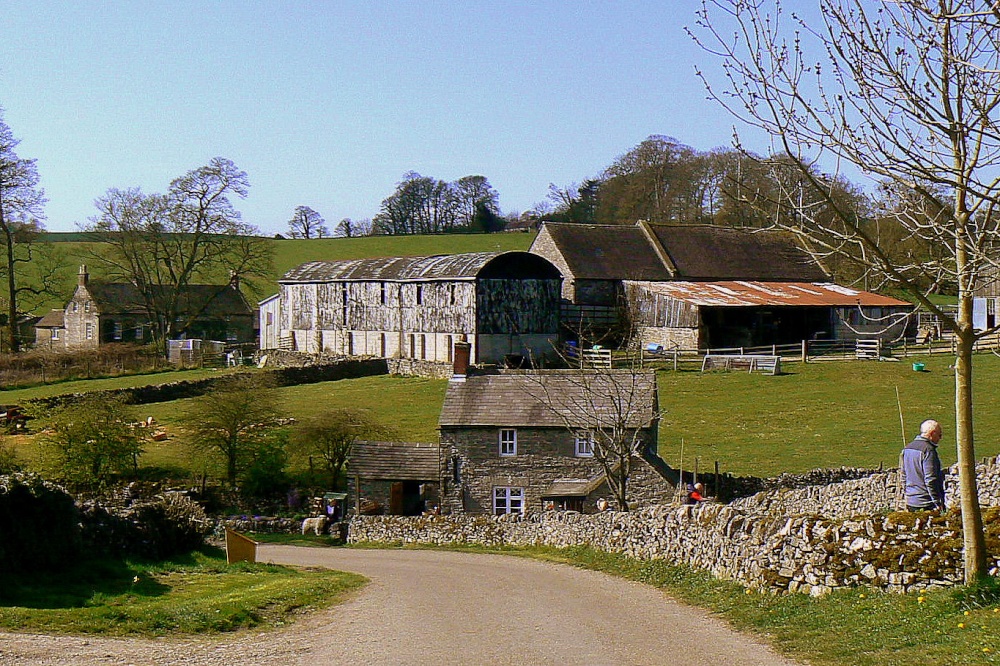
Tissington - Image by PicturesOfEngland.com member Christine Cooney (view gallery)
There are those to whom the ancient tradition of Well Dressing is a nothing less than a Pagan rite, and those to whom it represents a thanksgiving from the village for a safe deliverance from the nightmare of the Black Death that struck this land during the 14th-century. The good people of Tissington believe they owe their survival to the pure waters that pour from their five, now famous wells.
The five wells are known as - Yewtree Well, Hands Well, Coffin Well, Town Well and Hall Well. For the ancient ceremony in which each Well is blessed, the villagers, using the petals from millions of flowers, dress the Wells in scenes from the Holy Bible. The means used for this are that each well is framed and the petals pressed into clay. The blessing takes place annually on ascension day and provides the village with a colourful event following the mournful tone of the preceeding days.
Not only do the wells get blessed each year but Tissington itself has been especially blest by the continueous patronage of the Fitzherbert family. Fitzherberts, have cared for Tissington since the reign of Elizabeth I . The village is dignified and serene and of all the gracious properties in the village the most handsome is Tissington Hall, built around 1609 by Francis Fitzherbert.
Attractively set out, with buildings of a softish grey limestone interspersed by broad greens and tall old trees, the village presents a very English scene. A few of the properties bear dates showing that they were built in the 19th-century, during a period of redevelopment and improvement undertaken by Sir Henry Fitzhertbert and his sister, Frances. The former village school was built by the Fitzherberts to commerate the coronation of Queen Victoria in 1837. It still bears the Fitzherbert coat of arms above the door but sadly, it is no longer a school.
The vicarage to the parish church of St. Mary is a delightful piece of architecture and dates from around 1730. St.Mary's church is of Norman origin but was greatly restored by the Fitzherberts in victorian times. The interior of the church houses many monuments, the most outstanding being an ornate tiered memorial to Francis Fitzherbert who died in 1619, his son and their wives.
If you do not visit Tissington for the Well Dressing ceremony then you should certainly visit for the sheer delight of seeing a village that has been well cared for and little disturbed by the passage of time. Tissington is just on the edge of the Peak District National Park and is but a few short miles from Ashbourne. The countryside all around is very beautiful. Not too many miles away are all the attractions of the Peak District - the Heights of Abraham, the Peak Valley Railway, Haddon Hall and Riber Castle.
ID#239
| Article Title | Author | Date |
| The Prettiest Streets in England | poe | 24th November 2020 |
| A look at some of the most famous views in England... | poe | 16th May 2020 |
| THE TRIAL OF THE PYX | Paul V. A. Johnson | 19th August 2019 |
| The Best Sandy Beaches in Dorset | poe | 7th June 2016 |
| 20 Of The Best Market Towns In England | poe | 1st June 2016 |
| A Human Heart and a Ghost Story in a Northamptonshire Church | Charles Moorhen | 30th October 2009 |
| Exploring the English Village Churchyard | Charles Moorhen | 29th October 2009 |
| Local Legends - The Basingstoke Burial | poe | 28th February 2008 |
| The Hidden Churches of Somerset | Louise Simmons | 6th February 2008 |
| The Hidden Churches of Oxfordshire | Louise Simmons | 6th February 2008 |